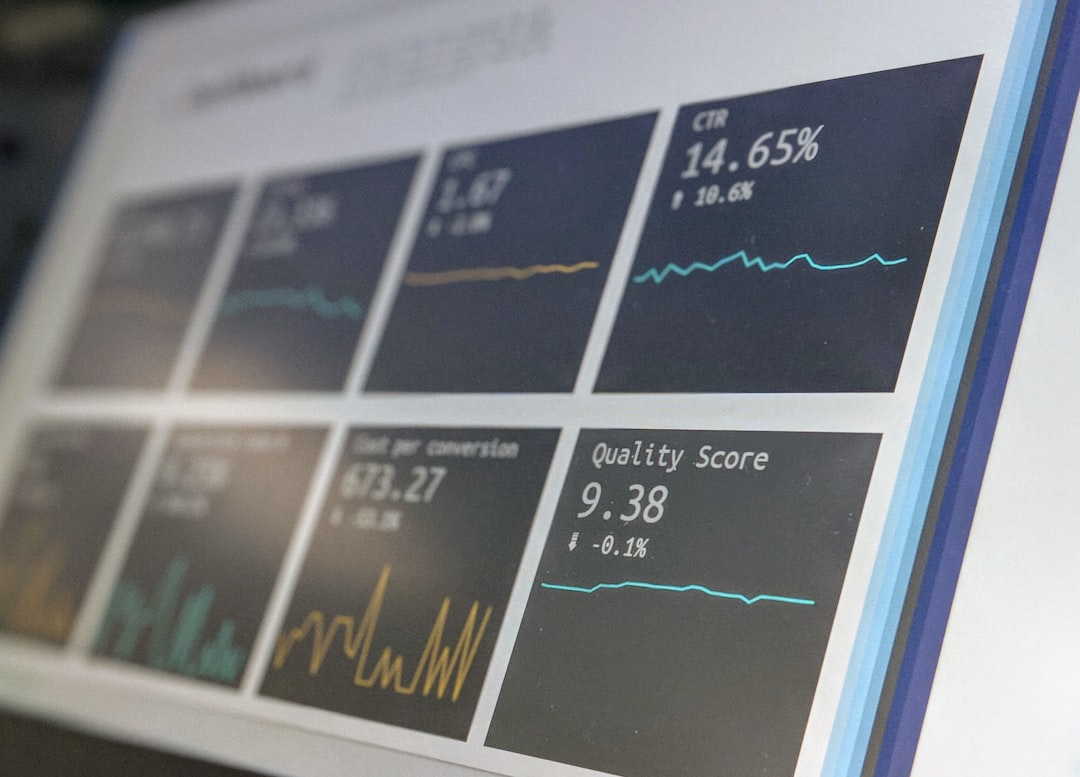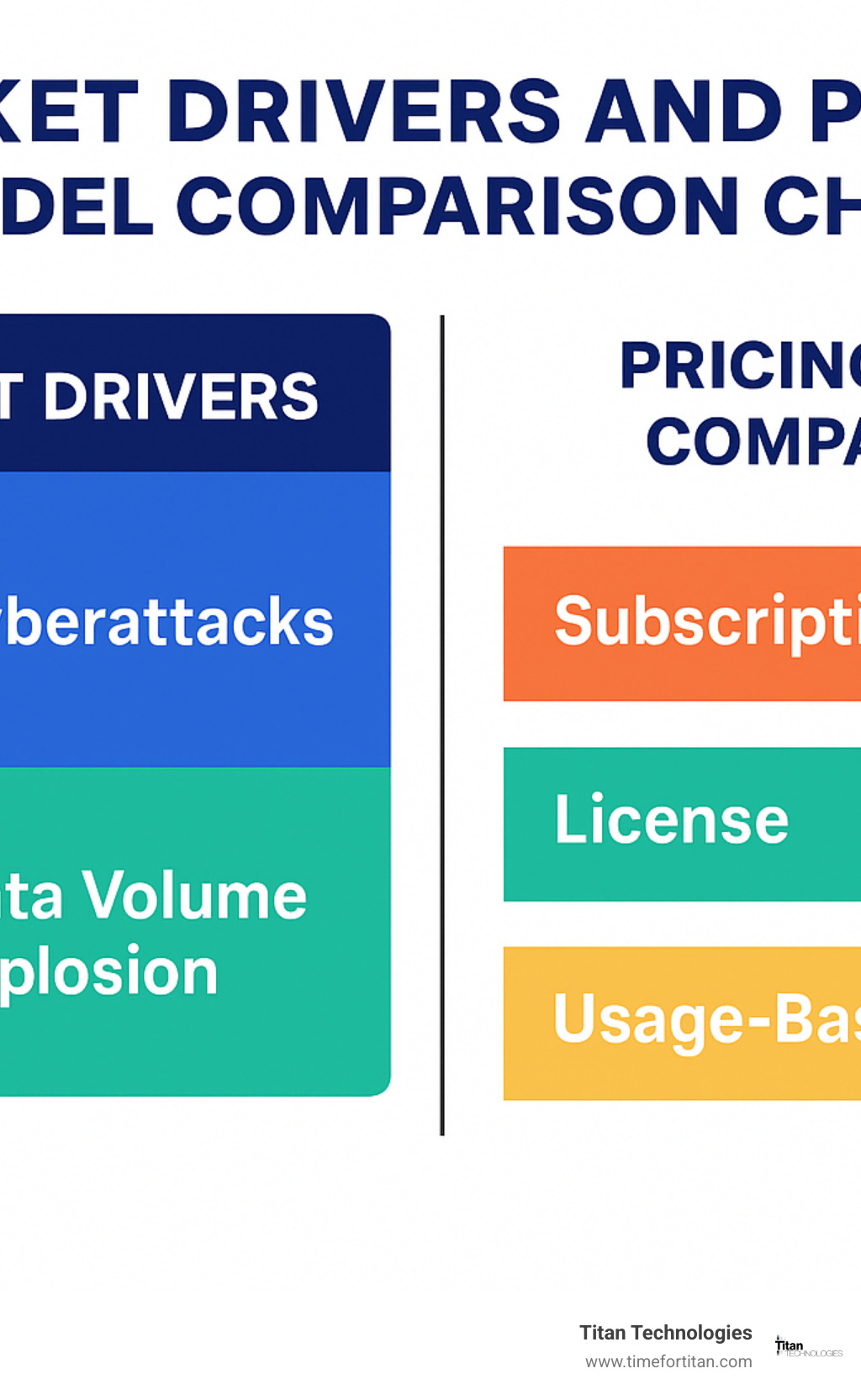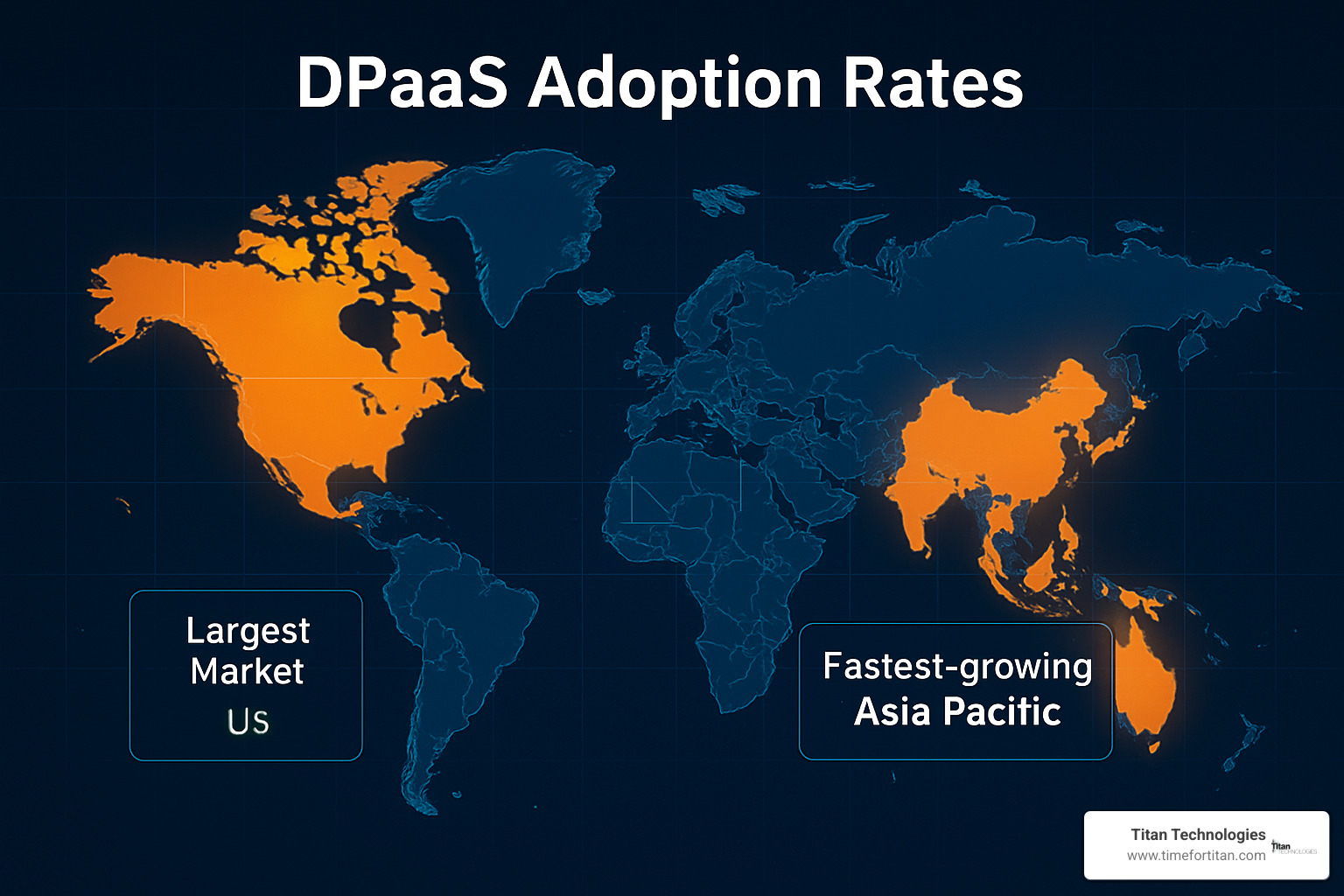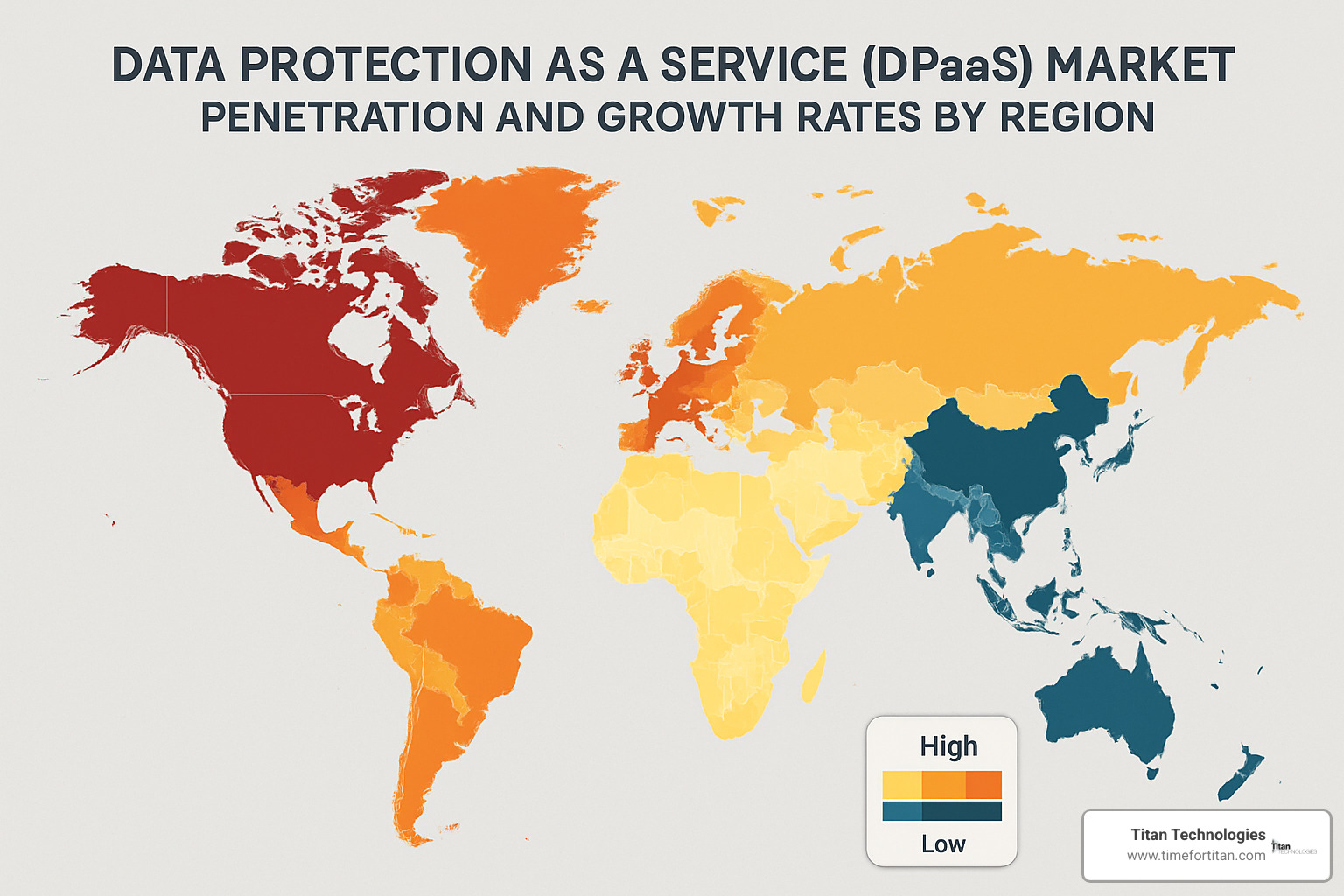Why the Data Protection as a Service Market is Changing Business Resilience
The data protection as a service market represents a fundamental shift in how organizations safeguard their critical data assets. This comprehensive guide explores the explosive growth, key trends, and strategic opportunities within this rapidly evolving sector.
Key Market Highlights:
– Market Size: $22.05 billion in 2023, projected to reach $106.05 billion by 2030
– Growth Rate: 25.9% CAGR from 2024-2030
– Leading Segment: Disaster Recovery as a Service (DRaaS) holds 38.3% market share
– Regional Leader: North America commands 39% of global revenue
– Fastest Growing: Storage as a Service (STaaS) shows highest projected growth rate
The surge in cyber threats has created an urgent need for robust data protection strategies. Recent studies show that over 57% of SMEs have experienced cybersecurity breaches, while the average data breach cost reached $4.45 million in 2023. Meanwhile, the shift to remote work and cloud-first operations has accelerated demand for scalable, managed data protection solutions.
Traditional on-premises backup systems simply can’t keep pace with today’s data volumes and sophisticated attack vectors. DPaaS offers a compelling alternative—combining enterprise-grade protection with subscription-based flexibility that makes advanced data resilience accessible to organizations of all sizes.
I’m Paul Nebb, founder of Titan Technologies and a cybersecurity expert with over 15 years of experience helping organizations steer the data protection as a service market. Through my work with clients ranging from small New Jersey businesses to large national corporations, I’ve witnessed how DPaaS transforms operational resilience and reduces IT complexity.
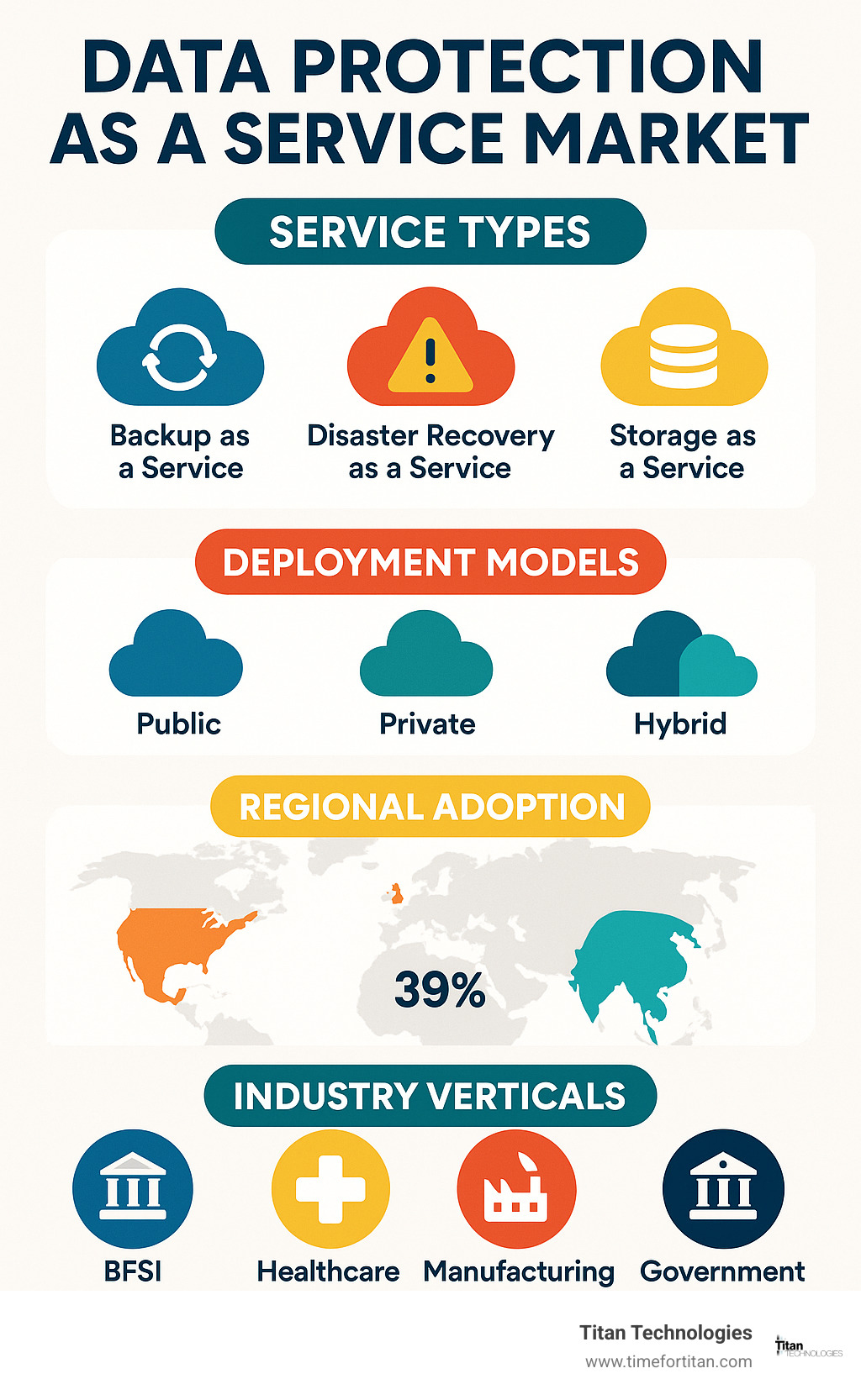
Data protection as a service market terms at a glance:
– data protection governance risk management and compliance
– data protection security controls
– enterprise data protection services
Global Data Protection as a Service Market Overview
The data protection as a service market has transformed from a specialized niche into an essential business lifeline. Think of it as the evolution from keeping your valuables in a home safe to using a state-of-the-art bank vault—except this vault is in the cloud and protects your digital assets around the clock.
The numbers tell an incredible story. The market hit USD 22.05 billion in 2023 and is racing toward USD 106.05 billion by 2030. That’s a 25.9% compound annual growth rate that reflects just how urgently businesses need better data protection.
This isn’t just about technology trends—it’s about survival. When a single hour of downtime can cost companies over $1 million, and cyber attacks are hitting businesses every 11 seconds, the old way of doing things simply doesn’t cut it anymore.
Disaster Recovery as a Service (DRaaS) leads the pack with 38.3% of market revenue, which makes perfect sense. Companies have learned the hard way that hoping for the best isn’t a business strategy. Meanwhile, private cloud deployments hold about 42% of the global market share, showing that businesses want security and control—but they also want the flexibility that cloud services provide.
The shift toward hybrid cloud architectures is particularly exciting. It’s like having the best of both worlds: the security of keeping your most sensitive data close to home, combined with the unlimited scalability of public cloud resources when you need them.
| Market Metric | 2023 Reality | 2030 Projection |
|---|---|---|
| Total Market Value | USD 22.05 Billion | USD 106.05 Billion |
| Annual Growth Rate | 25.9% CAGR | Sustained Growth |
| DRaaS Market Share | 38.3% | Leading Segment |
| Private Cloud Share | 42% | Strong Preference |
How the data protection as a service market works
Gone are the days of wrestling with tape drives or managing massive storage arrays in your server room. The data protection as a service market operates more like a utility—you turn on the tap, and clean water flows. Except in this case, you activate the service, and your data gets protected automatically.
The magic happens through cloud-native backup systems that work behind the scenes. Instead of manual processes that require someone to remember to swap tapes or check backup logs, everything runs automatically. Your data gets copied, verified, and stored across multiple locations without anyone having to babysit the process.
Subscription billing changes everything about budgeting for data protection. Rather than spending a fortune upfront on hardware that might become obsolete, you pay for what you use, when you use it. It’s like switching from buying a car to using a ride-share service—you get where you need to go without the maintenance headaches.
Multi-tenant portals give you a single dashboard to see everything happening with your data protection. No more logging into five different systems or wondering if last night’s backup actually worked. Everything is visible in one place, with alerts and reports that actually make sense.
The replication and failover orchestration happens automatically across geographically distributed data centers. If something goes wrong in one location, your data and applications can seamlessly switch to another site. It’s like having multiple escape routes that activate instantly when needed.
Core Service Segments: BaaS, DRaaS, STaaS
The data protection as a service market breaks down into three main flavors, each solving different pieces of the data protection puzzle.
Backup as a Service (BaaS) handles the fundamental job of creating and managing copies of your data. Think of it as your digital insurance policy—BaaS makes sure you always have clean copies of your files, databases, and applications stored safely in the cloud. The service automatically schedules backups, manages how long to keep different versions, and makes recovery as simple as clicking a button.
Disaster Recovery as a Service (DRaaS) takes things several steps further by maintaining complete duplicate environments ready to take over at a moment’s notice. When disaster strikes—whether it’s a ransomware attack, natural disaster, or major system failure—DRaaS can have your business running again in minutes rather than days or weeks. It’s like having a fully equipped backup office that’s always ready to go.
Storage as a Service (STaaS) provides the underlying foundation with elastic, intelligent storage that grows and shrinks based on your needs. The system automatically moves older data to cheaper storage tiers while keeping frequently accessed information on high-speed storage. Research shows STaaS is experiencing the fastest growth rate among all DPaaS service types, driven by the explosion in data volumes and the need for smarter data management.
What makes these services particularly powerful is how they work together. You’re not forced to choose just one—many organizations combine all three to create comprehensive protection that covers everything from simple file recovery to full business continuity.
More info about Data Protection Cloud-Based Services
Drivers, Segmentation & Pricing Models
The data protection as a service market is exploding because businesses are facing perfect storm conditions. On one hand, cyber threats are becoming more dangerous and expensive. On the other hand, traditional backup methods just can’t keep up with today’s data demands.
Let’s start with the elephant in the room: cyberattacks. The numbers are frankly scary. Manufacturing companies got hit with 68% of all ransomware attacks in just three months of 2023. Healthcare wasn’t much better, with data breaches exposing 124 million patient records last year. When you consider that the average data breach costs $4.45 million globally—and a whopping $9.44 million for U.S. companies—suddenly paying for professional data protection services doesn’t seem so expensive.
But it’s not just about attacks. Data volume explosion is creating headaches for IT teams everywhere. Think about it: every IoT sensor, every video call, every digital transaction creates data that needs protection. Traditional backup systems were designed for a simpler time. They’re like trying to fill a swimming pool with a garden hose—technically possible, but painfully slow and inefficient.
Regulatory pressure adds another layer of complexity. GDPR in Europe, HIPAA for healthcare, and new data protection laws popping up everywhere create a maze of compliance requirements. Most small and medium businesses don’t have lawyers and compliance experts on staff. DPaaS providers do.
The integration of AI and machine learning analytics is changing the game entirely. These smart systems can predict when hardware might fail, spot unusual data patterns that might signal an attack, and automatically classify sensitive information. It’s like having a crystal ball for your data protection strategy.
Growth catalysts in the data protection as a service market
Several specific trends are turbocharging growth in the data protection as a service market. IoT and edge data creation is exploding as smart devices become standard in everything from manufacturing floors to office buildings. Each connected device generates data streams that need protection, but they’re scattered across multiple locations instead of sitting safely in a central data center.
The talent shortage in cybersecurity is real and getting worse. Finding qualified professionals who understand modern data protection is like finding unicorns—they’re rare and expensive. Most businesses, especially smaller ones, simply can’t compete with tech giants for top cybersecurity talent. DPaaS providers pool expert resources across many clients, making enterprise-level expertise accessible to everyone.
Ransomware costs continue climbing at an alarming rate. Extreme cyber incident losses reached $2.5 billion in 2023—four times higher than just six years ago. When you realize that comprehensive data protection costs a fraction of ransomware recovery expenses, the math becomes pretty clear.
Modern businesses also face much tighter downtime tolerance. When systems go down, every minute counts. Some enterprises lose over $1 million per hour during outages. Traditional backup and recovery methods that take hours or days to restore systems simply don’t cut it anymore. Businesses need recovery times measured in minutes, not hours.
Deployment Choices & Cost Considerations
Choosing the right deployment model for your DPaaS solution is like picking the right tool for a job—there’s no one-size-fits-all answer, but there are definitely better choices for specific situations.
Public cloud deployments offer the most bang for your buck. By sharing infrastructure costs across many customers, providers can offer enterprise-grade protection at prices that small businesses can afford. The scalability is incredible—you can protect terabytes of data without buying a single piece of hardware. However, some regulated industries find public cloud environments don’t meet their strict compliance requirements.
Private cloud solutions provide more control and security, making them attractive for businesses handling sensitive data or operating under strict regulations. While they typically cost more, you get customization options and compliance capabilities that public cloud environments can’t always provide. Think of it as the difference between renting an apartment and owning a house—more expensive, but you get to call the shots.
Hybrid cloud architectures are becoming the sweet spot for many organizations. Research shows that 58% of businesses now use hybrid solutions for disaster recovery. This approach lets you keep sensitive data in private environments while leveraging public cloud resources for less critical workloads. It’s like having your cake and eating it too.
When calculating total cost of ownership, look beyond basic subscription fees. Data egress charges can add up quickly if you need to move large amounts of data frequently. Storage tier optimization can significantly impact costs—hot storage for frequently accessed data costs more than cold storage for archives. SLA tiers also affect pricing, with faster recovery guarantees commanding premium rates.
The key is matching your deployment choice to your actual business needs, not just picking the cheapest option. A slightly more expensive solution that meets your compliance requirements and recovery objectives will always be more cost-effective than a cheap solution that fails when you need it most.
Scientific research on cloud backup efficiency
Regional & Industry Adoption Landscape
The data protection as a service market tells a fascinating story when you look at where it’s growing fastest and which industries are leading the charge. It’s like watching a digital revolution unfold in real time, with some regions racing ahead while others are just getting started.
North America sits firmly in the driver’s seat, commanding 39% of the global market share. This shouldn’t surprise anyone familiar with the region’s tech-forward approach and complex regulatory landscape. The United States alone captures 80% of North American revenue, driven by everything from Silicon Valley startups to Wall Street financial giants who simply can’t afford to lose their data.
But here’s where it gets interesting—Asia-Pacific is the speed demon of the DPaaS world. While North America might have the biggest slice of the pie today, Asia-Pacific is growing faster than anywhere else. Countries like India are experiencing explosive growth thanks to government digitization programs and a rapidly expanding business sector that’s learning the hard way about cyber threats.
Europe presents its own unique story, shaped heavily by GDPR requirements and data sovereignty concerns. European organizations aren’t just thinking about protecting their data—they’re also worried about where it lives and who has access to it. This has created strong demand for private cloud and hybrid solutions that keep sensitive information within EU borders.
When we look at industries, Banking, Financial Services, and Insurance (BFSI) leads the pack. This makes perfect sense when you consider that a single data breach in finance can result in millions in fines and permanently damaged customer trust. These organizations were among the first to recognize that the cost of comprehensive data protection is a bargain compared to the potential cost of losing customer financial data.
Sector Spotlights inside the data protection as a service market
Different industries approach the data protection as a service market like they’re solving completely different puzzles, because in many ways, they are.
BFSI organizations treat data protection like Fort Knox security. They’re dealing with customer financial information, credit card numbers, and transaction histories that are pure gold to cybercriminals. The regulatory compliance requirements alone—think SOX, PCI DSS, and various banking regulations—create a complex web of requirements that DPaaS providers specialize in navigating.
Healthcare is experiencing the fastest growth of any vertical, and it’s not hard to understand why. Medical records contain some of the most sensitive information imaginable, and HIPAA violations can shut down practices overnight. When you add in the explosion of telemedicine and digital health records, healthcare organizations are generating more data than ever while facing increasingly sophisticated attacks.
The numbers tell a stark story: healthcare data breaches exposed 124 million records in 2023 alone. For a doctor’s office or hospital, this isn’t just a compliance issue—it’s about maintaining patient trust and potentially saving lives by ensuring critical systems stay operational.
Manufacturing industries are jumping into DPaaS as Industry 4.0 transforms their operations. Modern factories generate massive amounts of data from sensors, robotics, and automated systems. When ransomware hits a manufacturing plant, it doesn’t just steal data—it can shut down entire production lines, costing millions per hour in lost productivity.
Small and medium enterprises represent the fastest-growing segment by organization size, which is particularly exciting for businesses here in New Jersey. SMEs are finding they can access enterprise-grade protection without enterprise-grade budgets, leveling the playing field against larger competitors.
More info about Data Protection Services for Pharma
Geographic Trends & Sovereignty Considerations
Data sovereignty has become the wild card in the global data protection as a service market. It’s creating both challenges and opportunities as countries around the world decide they want more control over their citizens’ and businesses’ data.
The United States maintains its 80.4% share of North American revenue, but this dominance reflects more than just market size. American businesses face a complex patchwork of federal and state regulations—from CCPA in California to various industry-specific requirements—that create strong demand for specialized DPaaS solutions.
Europe operates under the long shadow of GDPR and the Schrems II decision, which essentially told businesses they couldn’t just ship European data to U.S. servers and call it a day. This has created fascinating market dynamics where European organizations are increasingly demanding hybrid solutions that keep sensitive data local while still leveraging global cloud infrastructure for other workloads.
India’s emergence as a major DPaaS market reflects the country’s ambitious digital change goals combined with growing concerns about data sovereignty. The Indian government’s push for “Digital India” has created massive opportunities for DPaaS providers, but also new requirements for local data storage and processing.
Latin America represents the next frontier, with countries across the region implementing new data protection frameworks while businesses accelerate their cloud adoption. It’s a region where the data protection as a service market could see explosive growth as regulatory frameworks mature and businesses recognize the value of comprehensive data protection.
Challenges, Compliance & Future Opportunities
Let’s be honest—while the data protection as a service market offers incredible opportunities, it’s not without its problems. Every organization considering DPaaS needs to understand these challenges upfront to make smart decisions and avoid costly mistakes down the road.
Latency issues can be a real headache, especially for businesses that need lightning-fast data access. When your backup data lives in a cloud center hundreds of miles away, those extra milliseconds can add up. It’s like having your emergency supplies stored in another city—they’re safe, but not exactly convenient when you need them immediately.
Provider lock-in represents another significant concern that keeps many IT managers awake at night. Once you’ve invested heavily in one DPaaS platform, switching providers can feel like trying to move an entire house—technically possible, but expensive and complicated. The proprietary formats and custom configurations that make each platform unique can become digital handcuffs over time.
Data sovereignty requirements continue creating compliance headaches as governments worldwide implement new rules about where data can live. What’s legal in one country might be prohibited in another, and these regulations change faster than most organizations can adapt their data protection strategies.
Budget constraints hit small and medium enterprises particularly hard. While everyone recognizes that comprehensive data protection is essential, the ongoing costs can strain tight IT budgets. It’s the classic challenge of needing enterprise-grade protection on a small business budget.
The talent shortage in cybersecurity and data protection makes everything more difficult. Finding qualified professionals who understand both the technical and compliance aspects of DPaaS implementation feels like searching for unicorns. This scarcity drives up costs and extends implementation timelines.
Regulatory compliance with frameworks like GDPR, CCPA, and HIPAA requires careful evaluation of every DPaaS solution. Organizations must ensure their chosen provider can demonstrate compliance and provide the documentation needed for audits. One compliance failure can result in penalties that dwarf the cost of the entire data protection program.
Latest research on market dynamics
Innovation Hot-Spots & Differentiation
Despite these challenges, the data protection as a service market continues evolving at breakneck speed. The innovations emerging today are genuinely exciting and address many of the traditional pain points that have frustrated IT teams for years.
Predictive recovery powered by machine learning represents a game-changing advancement. Instead of waiting for systems to fail, these smart platforms analyze patterns and predict problems before they happen. It’s like having a crystal ball for your IT infrastructure—except this one actually works.
Cyber-resilience orchestration takes data protection beyond simple backup and recovery. These integrated platforms coordinate backup verification, threat detection, and incident response in a single, unified workflow. When a ransomware attack hits, the system automatically verifies backup integrity while launching recovery procedures—no human intervention required.
Unified dashboards finally solve the nightmare of managing multiple backup solutions across different environments. Instead of juggling five different interfaces, IT teams get one comprehensive view of their entire data protection landscape. It’s the difference between conducting an orchestra and trying to play every instrument yourself.
Sustainability-focused storage innovations address growing environmental concerns while potentially reducing costs. These systems automatically optimize energy consumption and implement intelligent data lifecycle management that eliminates unnecessary storage waste. Your CFO and your environmental compliance officer will both be happy.
AI-driven automation is changing routine data protection operations from manual chores into automatic processes. The system optimizes backup schedules, manages retention policies, and handles routine recovery requests without human intervention. IT teams can finally focus on strategic initiatives instead of babysitting backup jobs.
Immutable backup technologies provide crucial protection against ransomware attacks by creating backup copies that cannot be modified or deleted, even by privileged users or compromised systems. When attackers try to encrypt your backups along with your production data, immutable copies remain safely untouchable.
Zero-trust integration ensures that data protection systems maintain security consistency with broader organizational security architectures. Every access request gets verified, whether it’s coming from the CEO’s laptop or an automated backup process.
These innovations aren’t just technical novelties—they’re solving real business problems that have plagued organizations for years. The data protection as a service market is becoming more intelligent, more automated, and more aligned with actual business needs.
More info about Data Protection Security Controls
Frequently Asked Questions about the Data Protection as a Service Market
What does DPaaS cost compared to on-prem backup?
When business owners ask me about data protection as a service market costs, I always start with a simple truth: comparing DPaaS to on-premises backup isn’t just about monthly fees versus hardware purchases. The real story involves hidden costs that many organizations don’t find until they’re knee-deep in managing their own backup systems.
Traditional on-premises backup feels cheaper at first glance. You buy servers, storage arrays, and backup software, then depreciate those assets over several years. But here’s what catches most businesses off guard—the ongoing expenses that keep piling up month after month.
Your IT team spends countless hours managing backup jobs, troubleshooting failed backups, and maintaining aging hardware. When storage fills up, you’re buying more drives. When backup software needs updates, you’re paying for new licenses. Don’t forget about the electricity bills, cooling costs, and that expensive disaster recovery site you need for true business protection.
DPaaS flips this model completely. Instead of large upfront investments, you pay predictable monthly fees that scale with your actual data usage. No surprise hardware failures, no emergency storage purchases, and no weekend calls about failed backup jobs.
The real savings become clear when you calculate the total cost of ownership. Most organizations find that DPaaS actually costs less than properly implemented on-premises solutions, especially when you factor in the value of your team’s time and the improved reliability that prevents costly downtime.
How does DPaaS help meet GDPR & HIPAA requirements?
Regulatory compliance keeps many business owners awake at night, and for good reason. GDPR fines can reach 4% of annual revenue, while HIPAA violations average $2.2 million per incident. The data protection as a service market has evolved specifically to address these compliance challenges.
GDPR requires organizations to implement comprehensive data protection controls, including encryption at rest and in transit, detailed audit logs, and the ability to respond to data subject requests within strict timeframes. Building these capabilities internally requires specialized expertise that most organizations simply don’t have.
Leading DPaaS providers have invested millions in building GDPR-compliant platforms that automatically implement required controls. Your data gets encrypted using enterprise-grade algorithms, access attempts are logged and monitored, and you receive detailed compliance reports that satisfy auditor requirements.
HIPAA compliance presents similar challenges for healthcare organizations handling protected health information. The regulations require specific technical safeguards, administrative controls, and business associate agreements that can be complex to implement correctly.
DPaaS providers serving healthcare markets typically offer HIPAA-compliant services with built-in safeguards and proper contractual protections. This shared compliance model means you benefit from their specialized expertise and dedicated compliance teams without having to build these capabilities yourself.
The beauty of this approach lies in the economies of scale. Instead of each organization struggling to interpret complex regulations and implement proper controls, DPaaS providers create compliant platforms that serve hundreds or thousands of customers, spreading the compliance investment across their entire customer base.
Can SMEs adopt private-cloud DPaaS without large budgets?
Small and medium enterprises often feel caught between a rock and a hard place when it comes to data protection. They need enterprise-grade security but lack enterprise-sized budgets. The good news is that the data protection as a service market has developed several approaches that make private cloud capabilities accessible to smaller organizations.
Shared private cloud environments represent one of the most practical solutions. Multiple organizations share dedicated infrastructure while maintaining strict isolation between their data and applications. You get the security benefits of private cloud deployment without bearing the full cost of dedicated hardware.
Hybrid deployment models offer another smart approach for budget-conscious organizations. Keep your most sensitive data in private cloud environments while using cost-effective public cloud resources for less critical information. This strategy lets you prioritize your spending where security matters most.
Many DPaaS providers now offer tiered service levels that recognize not all data requires the same level of protection. Your financial records and customer data might warrant private cloud storage, while general business documents can use more economical storage tiers.
The key is working with providers who understand SME challenges and offer flexible solutions that can grow with your business. Start with basic protection for your most critical data, then expand coverage as your budget and requirements evolve.
At Titan Technologies, we’ve helped numerous New Jersey businesses find the right balance between security requirements and budget realities. The data protection as a service market continues evolving to serve organizations of all sizes, making enterprise-grade protection more accessible than ever before.
Conclusion
The data protection as a service market represents more than just a technology trend—it’s fundamentally changing how smart organizations think about keeping their data safe and their businesses running. When you look at the numbers—growing from $22.05 billion in 2023 to a projected $106.05 billion by 2030—it’s clear that this isn’t just another IT fad. It’s become essential for survival in our digital world.
If you’re evaluating DPaaS solutions for your organization, focus on finding vendors who truly understand your industry’s unique challenges. Look for providers who offer flexible deployment options that make sense for your budget and security needs, and who can help you steer the maze of regulatory requirements without breaking a sweat.
The most successful DPaaS implementations we’ve seen combine solid technical capabilities with smart strategic planning. It’s not just about backing up your data—it’s about building a protection strategy that grows with your business and adapts to whatever curveballs the future throws at you.
Here’s the reality: cyber threats aren’t slowing down, and your data volumes are only going to keep growing. The organizations that will thrive are those that use DPaaS to build resilient, scalable data protection strategies now, before they desperately need them. The trick is choosing solutions that solve today’s problems while giving you the flexibility to handle tomorrow’s challenges.
At Titan Technologies, we’ve helped dozens of organizations across Central New Jersey find their way through the data protection as a service market and implement solutions that actually work for their real-world needs. We don’t just throw technology at problems—we take time to understand your business, your budget, and your biggest headaches, then design protection strategies that deliver genuine value.
Whether you’re running a small business in Edison looking for backup solutions that won’t break the bank, or you’re managing a large enterprise in Princeton that needs bulletproof disaster recovery capabilities, the DPaaS market has options that can transform how you protect your critical data. The secret sauce is partnering with people who understand both the technology landscape and what keeps you up at night worrying about your business.
Ready to explore how DPaaS can make your organization more resilient? Contact Titan Technologies today to discuss what you actually need (not what some salesperson thinks you need) and learn how we can help you leverage the power of the data protection as a service market to protect what matters most to your business. With our 100% satisfaction guarantee and deep expertise in cybersecurity solutions, we’re your trusted partner for building next-generation data protection strategies that ensure your business keeps running no matter what happens.






